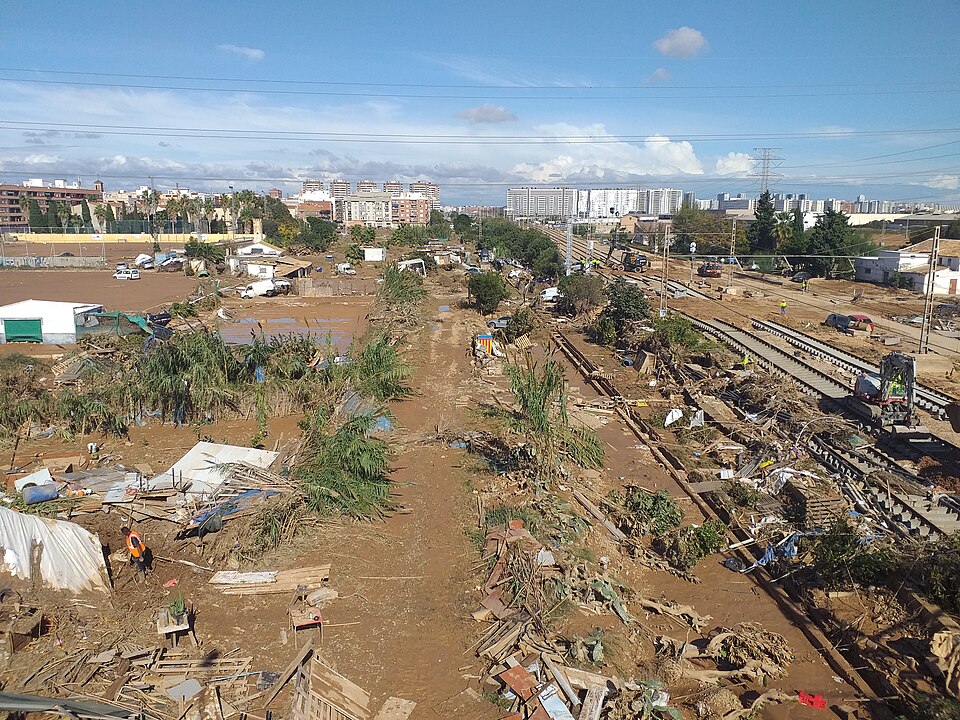In late October 2024, a cut-off low (COL)—known in Spain as a DANA (Depresión Aislada en Niveles Altos)—unleashed torrential rainfall across the Valencian region. In just twelve hours, up to 720 liters per square meter poured down, shattering local records. Now, a new study led by scientists from the Spanish National Research Council (CSIC) and the Complutense University of Madrid (UCM), within the EU-funded CLINT project, has confirmed what many suspected: climate change made this storm significantly wetter.
From event to evidence
Published in the Bulletin of the American Meteorological Society, the study shows that precipitation on 29 October 2024 was up to 20% higher than it would have been in a world without global warming. Yet, crucially, the research also finds that climate change did not cause the atmospheric phenomenon itself.
As lead author David Barriopedro (CSIC) explains, “The event would have occurred anyway—but the rainfall would have been less intense, because a cooler atmosphere would have contained less moisture available for storm formation.”
This distinction between cause and amplification matters. While global warming does not create every storm, it loads the atmosphere with energy and water vapor, increasing the likelihood that when storms do occur, they become more destructive.
Three lenses on one storm
The CLINT researchers approached the 2024 episode using three complementary attribution methods—each illuminating a different facet of how human influence interacts with natural variability.
- A probabilistic approach examined whether such extreme rainfall has become more frequent or intense over time. The result: no clear increase in the frequency of heavy precipitation events of this magnitude, highlighting the large natural variability of Mediterranean weather systems.
- An analog approach compared similar COL events in past and present climates. Here, a human fingerprint emerged: contemporary episodes tend to produce heavier rainfall than their historical counterparts, partly due to warmer sea-surface temperatures.
- A storyline approach, using AI-assisted weather simulations, recreated the storm under two scenarios—one with current greenhouse gas levels and another representing a world without human influence. The latter showed up to 20% less rainfall, confirming that global warming had intensified the downpour.
This triad of methods forms a multi-angle framework that enhances scientific confidence. “Each approach answers a different question,” says Barriopedro. “Together, they provide a fuller picture of climate change’s role in the disaster.”
What attribution really tells us
Attribution science—the study of how human-induced climate change affects specific weather events—has evolved rapidly in the past decade. Once considered impossible, it now allows scientists to quantify, with growing precision, how global warming modifies local extremes.
The 2024 Valencia case is a textbook example. The study’s authors emphasize that cut-off lows themselves are not becoming more common, but their impacts are changing. A warmer Mediterranean, combined with an atmosphere primed with moisture, sets the stage for more intense rainfall when these systems do occur.
According to José Manuel Garrido-Pérez (UCM), this pattern aligns with other observation-based studies. “The Mediterranean climate is highly variable. That’s why robust attribution requires multiple lines of evidence rather than a single model or dataset.”
Building resilience through knowledge
Beyond the scientific curiosity, attribution matters because it supports decision-making. Policymakers, engineers, and civil protection agencies can use this information to design more resilient infrastructures and adaptation policies grounded in evidence.
“The key is to build evidence,” notes Ricardo García-Herrera (UCM). “Attribution studies like this help communicate climate risks in a clear and balanced way, avoiding contradictory messages.”
By combining probabilistic, analog, and storyline approaches, the CLINT team offers not just academic insight but a practical tool for risk communication and early warning systems.
This integrative framework represents a step toward standardizing attribution research in Europe—an aim aligned with the CLINT project’s mission to improve climate intelligence through machine learning and data-driven models.
A storm, a signal, and a lesson
What emerges from the Valencia storm is not a single statistic but a narrative: human activity is subtly but measurably changing the intensity of Mediterranean weather extremes. While natural variability will continue to shape when and where cut-off lows form, the energy and moisture content of the atmosphere is now fundamentally different.
For a region accustomed to sudden deluges and droughts, this shift poses a challenge. Attribution studies like this one bridge the gap between scientific analysis and societal preparedness. They remind us that the physics of the atmosphere are changing—and that understanding those changes is the first step to mitigating their impact.
The authors—Barriopedro, Jiménez-Esteve, Collazo, Garrido-Pérez, Johnson, and García-Herrera—conclude that building such multi-method evidence “confirms a new climatic reality and underscores the need for joint action between science, institutions, and citizens.”
When the next DANA forms over the Mediterranean, it will not be caused by climate change alone. But its voice in the sky—louder, wetter, and harder to ignore—will carry the unmistakable echo of a warming world.
Read the full paper here
Barriopedro, D., Jiménez-Esteve, B., Collazo, S., Garrido-Pérez, J. M., Johnson, J. E., y García-Herrera, R.
(2025). A multi-method attribution analysis of Spain’s 2024 extreme precipitation event. Bulletin of
the American Meteorological Society. https://doi.org/10.1175/BAMS-D-25-0049.1




